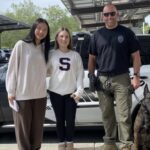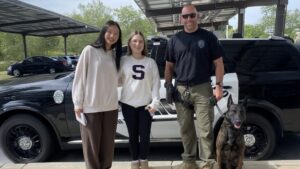
(CLAIR | Simi Valley, CA) – A growing number of local residents are voicing concerns about debris from the recent Eaton Fire being transported to the Simi Valley Landfill. Some fear that hazardous materials could pose health risks, while others believe the process is safe and well-regulated. The controversy has led to discussions on social media, at local meetings, and in conversations with city officials.
So, what exactly is happening at the landfill? And should residents be worried?
Understanding the Process: What’s Being Dumped at the Simi Valley Landfill?
Waste Management, which operates the Simi Valley Landfill & Recycling Center, has addressed concerns by emphasizing that the landfill is a non-hazardous waste facility. This means it cannot accept hazardous materials such as asbestos, lead, or chemical waste.
Before fire debris is transported to the landfill, it undergoes a strict two-phase cleanup process:
Phase 1: The U.S. Environmental Protection Agency (EPA) and Army Corps of Engineers assess fire-damaged areas, removing all hazardous materials like batteries, paint, and asbestos-containing debris.
Phase 2: Only after the hazardous waste is removed can non-hazardous ash, concrete, wood, and other debris be transported to designated landfills, including Simi Valley, Azusa, and other locations.
“All materials arriving at the landfill undergo a rigorous verification process to ensure they meet non-hazardous criteria,” Waste Management said in a statement. “The Simi Valley Landfill has long supported communities after natural disasters, ensuring a safe and environmentally responsible disposal process.”
But despite these assurances, some residents remain unconvinced.
Rocketdyne’s Shadow Looms Over Simi Valley’s Waste History
For some in Simi Valley, concerns about hazardous waste are deeply tied to the legacy of Rocketdyne, a former aerospace and nuclear testing facility in the Santa Susana Mountains. The site, officially known as the Santa Susana Field Laboratory (SSFL), experienced a partial nuclear meltdown in 1959, releasing radioactive contamination into the surrounding area.
The SSFL site remains one of California’s most controversial cleanup locations, with ongoing debates over soil and groundwater contamination. For some longtime residents, the idea of bringing any fire debris—even if classified as “non-hazardous”—to Simi Valley is simply too close for comfort.
Many have expressed concern that the city already has a history of toxic exposure risks, and allowing additional debris to be dumped in Simi Valley raises more questions about airborne pollutants and long-term contamination.
What Are Residents Saying?
The topic has sparked heated discussions online, particularly on community forums, where posts about the landfill have received significant engagement. Some residents have expressed frustration over what they see as a lack of transparency from officials.
One concerned individual recently posted online after hearing a report on the radio: “I called the city for answers and got no response. Has anyone else heard about this? This is very scary!!”
Another resident raised concerns about the potential for wind to carry airborne ash from the landfill: “This debris will be flying everywhere! I bet the workers handling it will be in full PPE gear while we just breathe it in.”
Others have pushed back against the fear, arguing that the cleanup process is well-regulated and that fire debris is being properly sorted.
A construction industry professional commented: “I work in the building industry. Waste disposal is highly regulated. Lead and asbestos are removed first. People need to stop spreading irrational fear.”
Another resident added: “The landfill doesn’t just dump the debris in an open field. It’s buried under engineered layers, preventing exposure.”
Despite these assurances, many in the community remain skeptical. Some are calling for a formal protest, while others are urging local officials to demand more oversight and transparency.
City officials acknowledge the concerns raised by residents but emphasize strict precautions are in place to ensure safety and compliance with environmental regulations.
Some in the community, however, are demanding more proactive action from local representatives.
One resident suggested that city officials should be doing more: “If Simi Valley doesn’t have a say, then our local leaders should be pressuring the county and state to reject this. Los Angeles County should deal with its own waste.”
For those wanting to stay informed, consider the following:
- Attend Local Meetings – Neighborhood Council meetings have become a key forum for discussion, with residents raising concerns about air quality, health risks, and landfill safety. Future meetings will likely continue addressing these topics.
- Stay Updated on Regulations – Understanding how fire debris is processed and monitored can help residents make informed decisions. Checking updates from the EPA, Ventura County officials, and Waste Management can provide clarity on the situation.
- Engage with Local Officials – Reaching out to city and county representatives ensures community voices are heard. Asking for increased transparency or additional safety measures can influence future decisions.
- Follow Environmental Reports – Tracking data on air quality and landfill monitoring can help assess any potential risks. Local environmental groups may also provide independent analysis.
- Share Concerns with the Community – Open discussions through local forums, social media, or town hall meetings can keep the issue visible and encourage collective action.
As new developments emerge, staying engaged will be key to ensuring that Simi Valley’s concerns are addressed. For those seeking more information on landfill regulations, visit the Simi Valley Landfill & Recycling Center website or attend the next City Council or Neighborhood Council meeting.















The Simi Valley Landfill is regulated by 3 permits, none of which are issued by the City of Simi Valley. Its a complete waste of time, in terms of protecting the health of Simi Valley and Moorpark residents to lobby or express concerns to anyone on the Simi Valley City Council.
The principal government regulators in charge of the Simi Valley Landfill are the Ventura County Board of Supervisors. Unlike in the past 40 years, no one who lives in Simi Valley is on that Board. Instead Simi Valley is represented by Janice Parvin from Moorpark, a real estate agent in terms of her scientific training. Short of filing a lawsuit against Ventura County to stop “toxic” Fire Ash and Fire Debris from being disposed of in the Simi Valley Landfill, Supervisor Parvin is the person who should be hearing her phone ring off the wall from constituents who have opinions on the propriety of the use of the local landfill for Fire Ash and Fire Debris from another county.
Ventura County issued a Conditional Use Permit to NYSE list mega-million dollar company Waste Managment to operate the Simi Valley Landfill. Every load of Fire Ash and Fire Debris puts disposal fees in Waste Management”s pocket, so the occurrence of the big fires is a cash flow bonanza for Waste Managment.
At the very least that Conditionnal Use Permit states that no Hazardous Waste or Hazardous Materials can be disposed of in the Simi Valley Landfill. Theoretically Waste Management should be testing and inpecting every load from the fires, because it has been widely publicized that the Fire Ash is likely to contain lead, arsenic and other hazardous chemicals which result when plastic is burned in a fire. How much inspection and testing of each load of Fire Ash or Fire Debris will Waste Manabgement do? They’re not saying. Will employees of Ventura County be there at the landfill gates, watching the inspection and testing of the Fire Ash and Fire Debris by Waste Management employees, or doing the County’s own testing of loads? Not likely at this point.
The County of Ventura as agent or “LEA” for the State of California’s agency called CalRecycle also issued a State permit to Waste Management for the Simi Valley Landfill, which requires the landfill operator to comply with a large number of CalRecycle Regulations and State laws about landfills aka dumps. Theoretically Ventura County is supposed to be enforcing those laws and regulations with respect to the “toxic” Fire Ash and Fire Debris. The extent to which those inspections are made by County employees is also a matter of discretion on the part of the County Manager in controlling the County employees, unless the majority of the Board of Supevisors give her an explicitly directive like “We want every load coming from the fire areas to be tested.
The third permit the Simi Valley Landfill has is a Regional Water Quality Control Board permit, regulating what Waste Management does in terms of surface water run-off from the landfill, and underground water movement from the landfill property to other people’s property and the Arroyo Simi. There is a man at RW!CB who has given Waste Management letter waivers of the terms of that permit every time there is a big brushfire like the Thomas Fire or the Mountain Fire. Given all the rhetoric about the Fire Ash and Fire Debris being “toxic” concerned residents of Simi Valley and Moorpark, and farmers downstream in Moorpark, Somis and beyond should be paying attention to what “waivers” of that RWQCB Permit’s terms are being given in the contextg of the massive amount of Fire Ash and Fire Debris to be disposed of from these fires in LA County.
Illustrating the cluelessness of Simi Valley and Ventura County local government officials on the impacts of taking massive quantities of Fire Ash and/or Fire Debris in the Simi Valley Landfill, one dimbulbs executive with the City of Simi Valley would not comment on this issue except to say “I trust Waste Managmement.”
That foolish trust in any landfill owner or operator is exactly what the foolish Los Angeles County government officials said in Santa Clarita while the other huge American garbage dump company, Waste Connections operated the Chiquita Canyon Landfill where it turned out that massive quantities of illegal waste were disposed of there, as well as Fire Ash from the Woolsey Fire. Unfortunately soon after the disposal of the Woolsey Fire Ash was done, a gigantic unstoppable chemical reacction started inside the mountain of waste at the Chiquita Canyon Landfill, producing 4 kinds of toxic, flammable, explode gases wafting into ne9iighborhoods of homes and schools, in Castaic and Val Verde, with “The Stench” now traveling down into the City of Santa Clarita’s residential neighboods and into the very expensive Stevenson Ranch residential area which is in LA County’s turf. That Chiquita Canyon Landfill and its illegally disposed of waste have been the site off over 2,500 citations for the breaking of LA County, State and Federal lenvironmental laws due to the unstoppable toxic gas filled Stench. L.A. County has now sued Waste Connections,, as well as 2,000 homeowners suing that landfill operator to seek damages because Waste Connectioins cannot “Stop the Stench”. And now there are people living in Val Verde near that landfill, on specific street, who are coming down with cancers, since several of the landfill gases newly being released, after the Woolsey Fire ash Arrived, are carcinogenic. Waste Connections most recent solution was to simply close the Chiquita Canyon Landfill.
Its just my opinion, but both the Vedntura County elected officials and their top managers, and the Simi Valley City Council and their top managers come off as clueless morons in failing to carefully act on the dumping in their turf of what could easily be 2 Million Tons of LA County and LA City’s Fire Ash and/or Fire Debris.
its kinda funny it was going to go to the landfill in calabass but all the actors and actresses and singers that live there oh and lets not forget the kardashians and protested they didn’t want it in there area and its not going there but now simi is getting it when the fires weren’t even in ventura county what a bs thing this is. and i dont care what they say they are doing before it is brought here im doubting this is happening one those workers just want to get it done as fast as they can they don’t want to be around it and its just stupid to think there going to test it twice before bringing it here and once at the landfill there jiust going to put it in the landfill and that will be the end of it. if in 10 years we are all sick they will say it isn’t that because they checked it all. i don’t understand why ventura county doesn’t fight for anything but yet they wonder why is everyone leaving california. just look at this and maybe you will figure it out